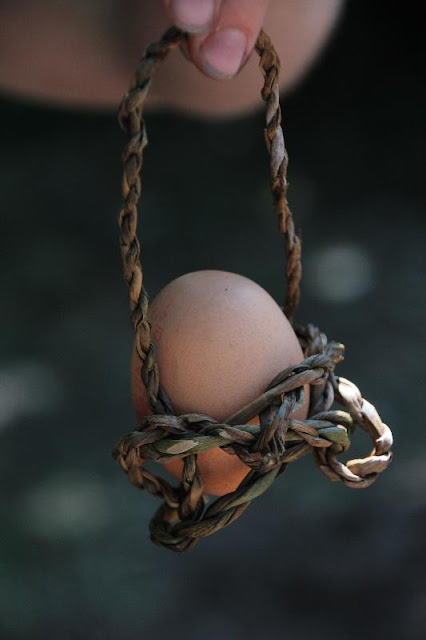There were archaeologists inside the roundhouse, making what I guess was what I made at guides years ago - damper ( an early form of unleavened bread)...
... and telling tales of life in the bronze age - and medicines from then.
The roundhouse is fantastic, it must have been a great experience working on building it with the NTS rangers.
Outside there was pot making. The potter was very interesting to talk to; he's also making replica pots for the new Stonehenge visitor centre. Sadly I didn't make notes and have forgotten a lot of what he said about the timings for firing the pots beside a fire like this.

I do remember him telling me about some of the experimental archaeology he's done though. He left some broken pots lying outside in his garden for 2 years. It was a great illustration of how quickly archaeological remains can be lost if they don't have some sort of protection.
After the first winter the pots had been broken by pots into smaller pieces, but were still recognisable and could presumably still be rebuilt by archaeologists (a bit like a jigsaw). During the 2nd year insects moved in to the layers in the weathered pots and started making their homes there.The weathering continues and frost plays its part in continuing to weather and break up the pots. Then of course, birds spot the insects and start moving about the broken, and increasingly small, pieces of pottery in search of a tasty meal. He said that after 2 years all that was really left was 'dust' and the odd small piece of pot. Amazing! So in what is really an incredibly short time archaeologically speaking there could be no evidence remaining of what was originally there.
That's an experiement I'd love to repeat with a class at school, if I could find the right context - and (much harder) a place where the pots wouldn't be disturbed by humans!
I'd also love to recreate the burnt mound experimental archaeology with pupils, but doubt I'd be allowed to. As for the brewing...
In the 'small world' way that things often work, it was someone from Orkney who was running the burnt mount archaeology part of the event.
This was a chance to experiment with the type and size of stone (though a lot will be known about that from what's found in burnt mounds) as well as how long the stones would need to be heated for, how often they could be heated before cracking and how fast the water would boil, how many stones it would need, etc. The first task they had to think about was how to seal the water tank - I think it was a local clay that was used.
The stones were heated for a couple of hours in the fire and then moved down to the tank...
... where they were pushed over the edge ...
... and landed with a splash.
It was incredible (to me anyway) how fast the water boiled, it certainly didn't take all of the stones which had been heated to make the water come to the boil within minutes.
Then it was time to boil an egg for lunch...
An unexpected (or less planned for anyway) part of this experiment was trying to work out how to get the boiled egg back out, not least because some of them vanished in amongst the stones in the boiling water! A short while later, and the egg holder was born! Made out of reeds I think.














No comments:
Post a Comment